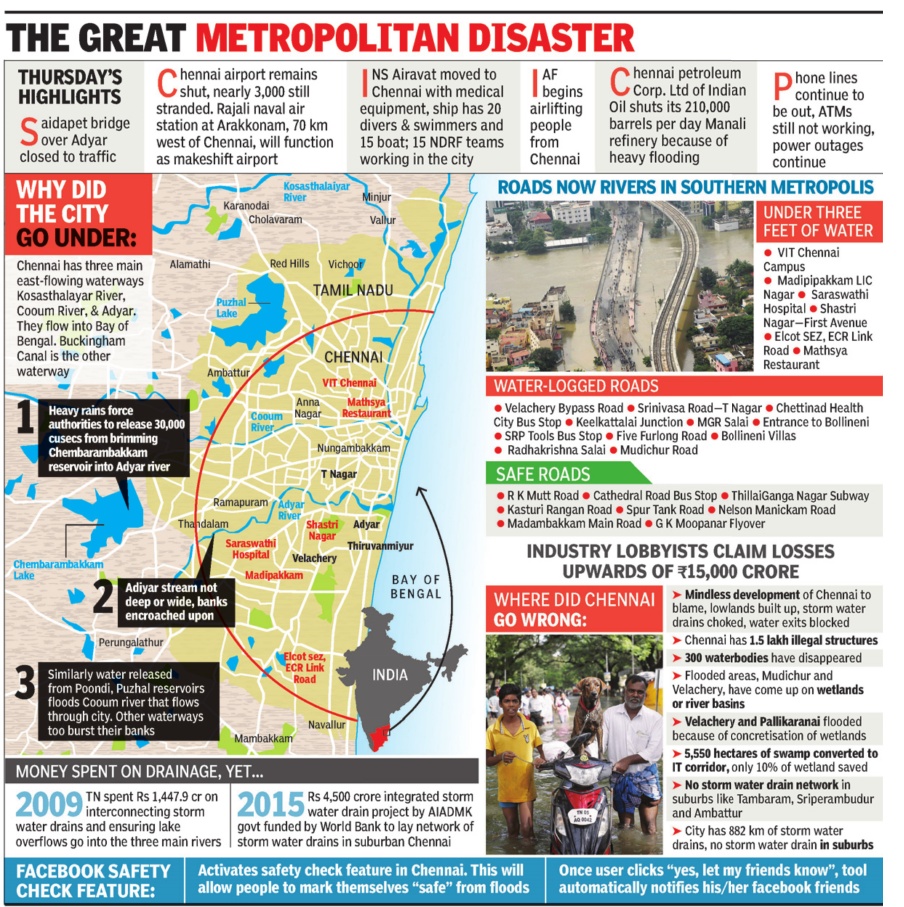Floods in Chennai

This is a collection of articles archived for the excellence of their content. |
December 2, 2015: Heaviest rain ever
The Times of India, Dec 03 2015 345mm In A Day Smashes 114-Yr Record
Chennai on 2 Dec 2015 recorded the heaviest-ever rainfall of 294mm and 345mm in the Met office's two observatories here in 24 hours, breaking the previous record of 261mm set in 1901. Level of 2 Dec 2015 was more than half the average rainfall for the entire northeast monsoon and pummelled an already stricken city into submission.
Large swathes of Tamil Nadu remained marooned, leaving over 200 people dead over the past month, with the Met department predicting further downpour over the next 48 hours.
The last time a natural calamity struck the state with such vehemence was the 2004 Asian tsunami. While the death toll was much higher at nearly 8,000, the damage and disruption this time is feared to be on a similar scale.
Prime Minister Narendra Modi held an emergency meeting with senior Cabinet ministers Arun Jaitley , Rajnath Singh, Sushma Swaraj and Venkaiah Naidu for an appraisal of the situation, which was followed by a discussion in Lok Sabha.
The Army , Navy , Air Force and National Disaster Response Force (NDRF) are out on the streets to rescue people from their flooded homes. But, rescue teams faced serious problems in re aching the interiors of Chennai, where most people are stuck in the floods.
“The entire southern part of the city is disconnected.There is no public transport running there. Two main bridges there have also been closed and water current is too high for our boats to reach there,“ National Disaster Response Force director-general O P Singh said.
Telecom minister Ravi Shankar Prasad has said that state-run operator BSNL will not charge anything for a week in Chennai. Skymet Weather chief meteorologist Mahesh Palawat attributed the heavy rainfall primarily to the El Nino phenomenon.
“Many typhoons were formed in the Pacific Ocean this year due to the warming of the ocean. But the Indian Ocean is cool compared to the Pacific, and the wind carried more moisture, bringing in extreme rainfall,“ said Palawat.
“Not many countries get rainfall in December. It is biting winter or summer, depending upon the continent in which you live. But TN receives most of its rain at this time of the year,“ he added.
Beyond Chennai, the American state of California and the Caribbean islands are the ones which receive rainfall in December, but the intensity is lower than what the Tamil Nadu capital has experienced since the start of December in 2015.
Runoff water management
The Times of India, Dec 04 2015
Runoff water management new mantra for planners
The increasing frequency of intense rainfall as witnessed in Chennai is changing traditional approaches to drainage with “retention and detention“ strategies that reduce peak flows and encourage local storage finding increasing favour with urban planners. Though the 347 mm rain -in contrast to the more usual 53 mm -that inundated Chennai in the past six days can challenge most sewage and drainage systems, mapping the urban needs of an area can help reduce pressure on the drainage system during normal rainfall and well as during surges. The traditional approach to drainage aims to remove water as quickly as possible from the point of collection but this can prove counter-productive during intense rainfall and in areas that might get wetter due to the effects of climate change.
Countries such as Singapore that have geared their water collection to harvest as much of the runoff as possible are moving to reduce peak flows by as much as 55% by using detention tanks. The city state's active, beautiful, clean (ABC) waters programme looks to both store and treat water near locations such as residential areas and parks. Newer constructions are encouraged to harvest water for local use such as cleaning, gardening and air cooling.
Storm water is channeled through parks that use natural media to filter water on its way to collection tanks and eventually reservoirs. This process is, of course, dependent on strong separation of sewage and drainage which is absent in most Indian cities. But the Chennai experience can give a major push to such solutions that find mention in the smart cities and the Atal mission for urban rejuvenation and urban transformation (AMRUT) programmes.